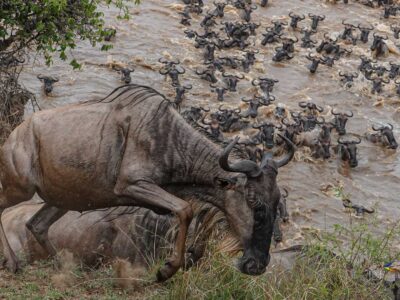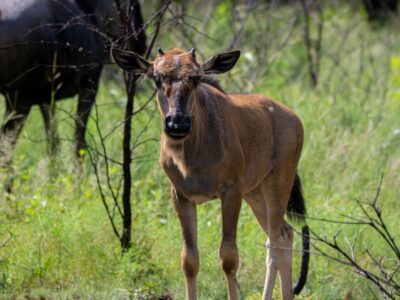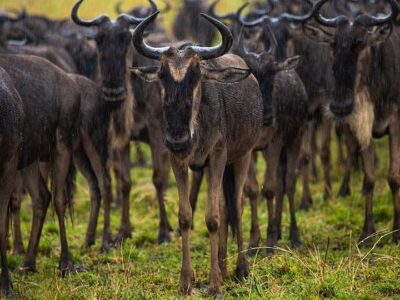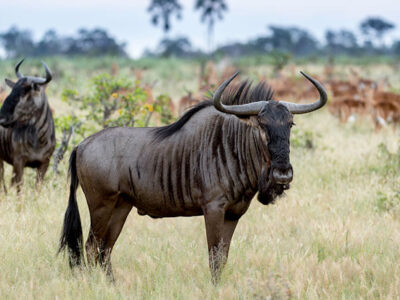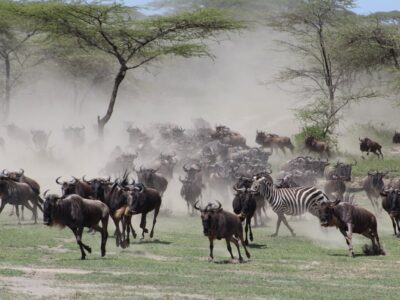The Wildebeest Facts, Behavior, Size, Diet, Habitat, And Tracker
Wildebeest
All you need to know about Wildebeests Facts, Behavior, Size, Diet, Habitat, And Tracker. Learn about their migration in Masai Mara and Serengeti National Park.
Facts
Wildebeests, also known as gnus, are large antelopes belonging to the bovine family. They are native to Africa, and primarily found in savannas and open woodlands. There are two species: the blue wildebeest (Connochaetes taurinus) and the black wildebeest (Connochaetes gnou). The blue wildebeest is the more common species and is famous for its role in the Great Migration, where over 1.5 million wildebeests travel annually across the Serengeti and Maasai Mara in search of fresh grazing land. Wildebeests have adapted to life in the wild with remarkable endurance, powerful legs for long-distance migration, and acute senses to detect predators. They are often seen in large herds alongside zebras and gazelles, benefiting from safety in numbers.
Behavior
Wildebeests are highly social animals that form large herds, particularly during migration. They exhibit strong herding instincts, staying together for protection against predators like lions, hyenas, and cheetahs. During the mating season, known as the “rut,” males engage in fierce battles to establish dominance over territories and attract females. Wildebeests are also known for their vocal communication, using grunts and bellows to alert the herd of danger. Their migration is driven by the seasonal availability of water and fresh grass, making them highly dependent on rainfall patterns. They are also capable of running at speeds of up to 80 km/h (50 mph) to escape predators.
Size
Adult wildebeests are robust and muscular, with a shoulder height of 1.2 to 1.5 meters (4 to 5 feet) and a body length of up to 2.5 meters (8 feet). Males, or bulls, are larger than females, weighing between 230 to 290 kg (510 to 640 lbs), while females typically weigh 160 to 260 kg (350 to 570 lbs). They have curved horns that grow up to 83 cm (33 inches) long, used for defense and dominance fights. Their bodies are covered in coarse fur, with a shaggy mane and a distinctive beard. The blue wildebeest has a dark grayish-blue coat, while the black wildebeest has a brownish-black coat with a striking white tail.
Diet
Wildebeests are herbivores, primarily feeding on short grasses found in open plains. They are grazers that depend on fresh, nutritious grass for survival, which is why their migration follows the rainfall. During the dry season, they may browse shrubs and leaves, but their preference remains young, tender grass. They rely on water daily, making them dependent on rivers and waterholes. Wildebeests play a crucial role in maintaining ecosystem balance by trimming grass, which allows new vegetation to grow and supports other grazing animals. Their feeding habits also help fertilize the soil, making them essential to their habitat’s health.
Habitat
Wildebeests inhabit the savannas, grasslands, and open woodlands of Eastern and Southern Africa, particularly in Tanzania, Kenya, Botswana, Namibia, and South Africa. The Serengeti-Mara ecosystem is their most famous habitat, where they migrate between the Serengeti National Park in Tanzania and Maasai Mara in Kenya. They thrive in areas with seasonal rainfall, ensuring fresh grass for grazing. Wildebeests prefer vast, open plains with few trees, allowing them to detect predators from a distance. They can also be found in semi-arid regions, demonstrating their adaptability to different environments.
Tracker
Tracking wildebeests is a key part of African safaris, especially for witnessing the Great Migration. Wildlife trackers and guides use various methods to follow their movements, including footprints, dung analysis, and behavioral patterns. Satellite tracking and radio collars have also helped researchers understand their migration routes. Wildebeests move in a cyclic pattern, crossing the Grumeti and Mara Rivers, facing dangerous crocodile-infested waters. The best time to track them is during the migration season from July to October in Kenya and December to May in Tanzania. Professional safari guides can predict their movement based on rainfall, grass availability, and past migration history, ensuring an unforgettable safari experience.
Talk To Our Experts Now
Travel Advice From JimJam Safaris
We cater to all ages, budgets, interests, and fitness levels. Our team can assist with queries about migration tours, Accommodations, bookings, and Affordable Luxury destinations. We will respond to your Inquiry as soon as possible. Our team of friendly and service-minded Safari Consultants is available to assist you in making a private, personalized, tailor-made Safari Itinerary and to answer all questions you might have. Are you dreaming of the Wildebeest Migration? Gorilla Trekking in Africa? Honeymoon In Africa or Africa’s Big 5 Experiences? Start Planning for Your Affordable Luxury African Safaris with JimJam Safaris & Tours Africa.
